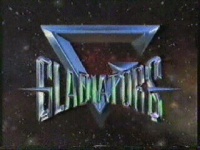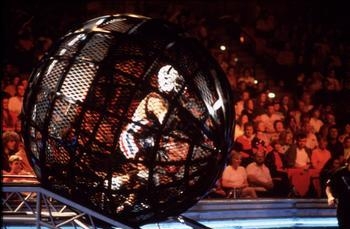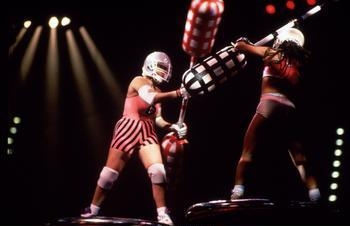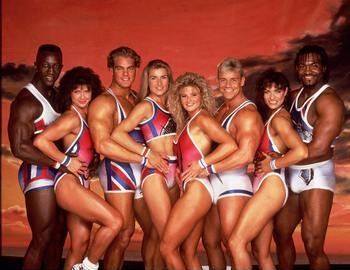Gladiators
(→New Place, New Face(s)) |
(Removed Awaiting Review Tag) |
||
| Line 181: | Line 181: | ||
[[Category:LWT Productions]] | [[Category:LWT Productions]] | ||
[[Category:Shine Productions]] | [[Category:Shine Productions]] | ||
| - | |||
Revision as of 22:04, 17 September 2008
Contents |
Host
Ulrika Jonsson with: John Fashanu (1992-6 & 1999-2000), Jeremy Guscott (1997-8)
International Gladiators (1995-6): John Fashanu and Mike Adamle (from American Gladiators)
"The Ashes" series (1996): John Fashanu and Kimberley Joseph (from Australian Gladiators)
Sky version: Ian Wright with: Kirsty Gallacher (2008)
Co-hosts
Commentator: John Sachs (1992-2000), Alan Parry (2008)
Referee: John Anderson
Broadcast
LWT for ITV, 10th October 1992 to 1st January 2000 (132 episodes)
Shine Productions for Sky One, 11th May 2008 - present
Synopsis
Gladiators... are you ready?
A pair of male and a pair of female preternaturally fit but otherwise perfectly normal members of the public (many with trifling claims to fame like being world kick-boxing champion, representing their country at diving, playing professional rugby or somesuch) adopt the role of con-ten-derrrrs to take on the might of trained Gladiators with similarly awesome names in a series of pseudo-combative events, aiming to earn as many points as possible. The contender with most points from each pair earns a half-second head-start for each point difference in a race over a fearsome oversized assault course. John Sachs provides crazed voiceover commentary while Ulrika and whoever is the resident sporty bloke at the time provide rich tea and sympathy with interviews between the events.
Sounds naff? It was one of the defining game shows of the 1990s and not without good reason. The show is derived from the original American Gladiators which, contrary to expectations, had only a tiny fraction of the glitz, glamour and budget of the interpretations of the format in the rest of the world - and a pathetically small arena, too.
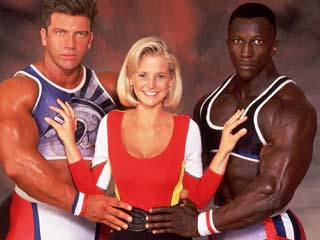 Host Ulrika Jonsson, with Mr Nice and Mr Nasty
Host Ulrika Jonsson, with Mr Nice and Mr NastyThe Gladiators themselves
A handful of Gladiators survived all seven series including the true beauty of the piece, the stunning Lightning (female); the lithe and lissom yet clownsome Cobra (male), the cheerful, reliable dreadlocked Saracen (fireman) and the good old-fashioned panto baddie Wolf (canine).
The rest of the female Glads have been rather anonymous, save for original pin-up Jet, who has since plummeted into obscurity using her real name Diane Youdale, and the occasional appearance for a season or two by random jobbing Olympian medallists. (Shot-putter Judy Oakes retired after six Commonwealth Games medals; should the show return, surely a good outside bet for a future female Glad with a real difference from most)
The male gladiators have more defined charisma: Hunter has a broad smile, ridiculous ability at every single damn game and a silly accent; Shadow was claimed as being twenty stones of solid muscle and stare in the first series (though all the Glads' claimed weights fell in series two and beyond as steroid use allegations befell the show) and was the Glads' spiritual leader until scandalised by links with cocaine; Warrior was the archetypal strongman who played hard but fair; Rhino "is six feet tall... but he's nine feet wide!" and so forth.
Gladiators: A potted history
When it first appeared in the UK it was new, it was fresh and it was exciting. The American version which regularly filled the extremely late night weekend slots had already gained a cult reputation and when the British version hit the scene it set a new standard for glamour, glitz and fun for Saturday evening shows.
Up against the almost as exciting (at the time) Noel's House Party (i.e. when it was actually good) British audiences had never seen the likes of grown men and women hitting each other over the heads with outsize cotton buds, rolling around in giant Hamster balls and Bungee jumping (where you got "more bounce to the ounce"). Despite the fact they played the same six games every week it still enthralled its audience. Who cares that the games didn't really have much of an effect on The Eliminator? It was fun! And got Britain fit again. It had drama too, Warrior broke his leg in an Atlasphere or something like that.
The series one games were:
Atlaspheres - One of the best games visually, but often not a high scoring game. Roll around in steel cages with the aim of rolling over one of four pods, scoring points and triggering a smoke effect into the bargain.
Wall - Contenders scramble up a climbing wall with hand and footholds while the Glads are around 15 seconds behind. Get to the top of the wall before you get pulled off by your pursuing Glad and you're ten points the richer.
Danger Zone - Contestants must dodge tennis balls being served at Sampras speed by the Gladiator standing on a large construction, atop which was a target. Players could try firing increasingly silly missiles at the target for 10 points, or just get around the course without being hit for a consolation 5.
Swingshot - Boing! In this bungee-fest, contestants had to grab yellow (1 point), blue (2 points) or red (3 points) balls from a central column then bounce back and put them in their scoring baskets. Glads would time their jumps so as to block the contestants movements.
Hang Tough - Contenders aim to swing across a grid of rings from one side to the other. Nine times out of ten, the Gladiator who starts from the other side of the grid catches up with them mid-way and pulls them off the rings.
Duel - Contender and Glad attempt to knock each other off elevated platforms with giant padded boffing sticks. Most women's duels are thirty-second defensive affairs with much thud and blunder and not a great deal of subtlety, but a men's duel is a thing of great cunning and beauty, the end appearing at any moment within the half minute.
Series two saw an extended run with loads of new games added. Now you could see grown men and women attempt to blow each other up (Skytrak - the standards of spelling of the nation after this series dropped dramatically), watch people whack each other over the head with different shaped outsized cotton buds (Suspension Bridge), watch televised Tug-O-Wars on surfboards (Tilt). And then halfway through they invented Duel-on-a-Bucking-Bronco (Joust). and the terribly overplayed Gauntlet. Double the amount of episodes and more viewers. Tony Blair says that Gladiators is great, but that's probably a couple of years later because he would have been an unknown then.
Series three saw the inclusion of four games, two really good and two really indifferent. Pyramid allowed people to see grown men and women jump up a giant Bouncy Castle (erm, a pyramid made of foam) and Pursuit made Kiss Chase fashionable again.
Series four and it was beginning to get a bit tedious to be honest. I think Sumo Ball was invented then but it was rubbish.
Series five and, worried that the general public were getting a bit bored, they invented "Tightrope", which had nothing to do with a tight-rope. It was rubbish, as despite being a spectacular game played high up in the arena, victory hinged on being able to undo a clip quickly. This all kept the public happy anyway. We liked the different shaped cotton-buds.
There were a couple of superb new games. Poleaxe involved grown adults climbing up a pole as fast as they possibly could and if you lost you were dropped 40ft onto a crash mat. This looked spectacular, though unfortunately it did someone's back in. So they put people on safety ropes in future series, which wasn't nearly as good. And there was the brilliant Pendulum which saw sales of climbing frames beat its current recession and enter a peak period and probably helped the economy no end.
But sadly about this time people had decided one thing: different shaped cotton-buds might be all well and good (because we like different shaped cotton-buds) but do we actually give a damn anymore? People were turning off in their droves.
In an attempt to revive its ailing audience, they tried to make Wolf a good actor and start a few fights. They failed on both counts. But by about this point no-one really cared. Except for my old IT teacher who was in the audience because a friend of his made the semi-final. And lost.
Re-incarnations
But what of its other incarnations? International Gladiators worked for a while with Mike Adamle (of American Glads fame) hosting with the Fash. Renowned for useless contestants from Eastern Europe.
There was an Ashes series which introduced us to a range of the Australian Gladiators.
They did the Champion of Champions which a likable Scouse heroine won (see Key moments below).
There was a forces special too, with several of the armed services competing.
And then there's children's Gladiators, or more accurately Gladiators: Train to Win, which sounded like a great idea, as kids loved Gladiators! And they'd rather have kids on TV doing it safely than bashing each others brains out with pillows doing "Duel" and falling down the stairs trying to do "The Wall". Its first series was inspired by the terrible Gladiators 2000 and its tacky wholesomeness shined through. Luckily they changed it from series two onwards so it was more action packed, the hot Gladiator-on-Gladiator action was apparently "the first time it's ever been done in the world." Fantastic stuff. Oh hang on, there seems to be a pool of about 6 games which haven't changed since Series 2. Oh.
There was a one-off charity special which involved jockeys for some reason. Needless to say, they lost.
Coroner's report
So Gladiators's Cause of Death? Forensic evidence suggests lack of new and good games and suffocation in early series by playing the Wall every single flippin' week.
Gladiators Ready! (Again)
So after an eight year break, Gladiators returns, this time to Sky One, and it’s a bit of a mixed bag, with as many similarities as differences. Several features of the old show make a welcome return, while the show also stamps it’s own 21st Century identity on the format.
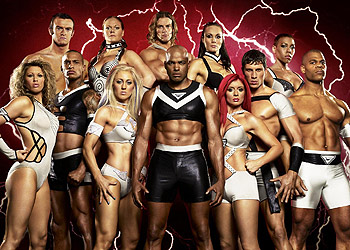 Here they come again, this time with Superstars champ Du'aine Ladejo as Predator (centre).
Here they come again, this time with Superstars champ Du'aine Ladejo as Predator (centre).
The biggest difference is obviously the Gladiators themselves. The likes of Wolf, Cobra, and Lightning have been replaced with muscle-bound athletes sporting names such as Destroyer, Oblivion, and Tempest. The new Gladiators are good at what they do; however it will take time for them to develop on-screen personalities like the original Gladiators did. Some more screen time in post-event interviews would help with this.
New Place, New Face(s)
Another big difference is the venue. Smaller than the National Indoor Arena previously used, this is a purpose-built affair, with a permanent water tank, a large foam pyramid, and various other platforms and steps all permanently laid out. The audience line the sides of the studio, with them being much closer to the action than they previously were, which adds to the atmosphere. The somewhat over the top use of spotlights and lasers also helps with the atmosphere.
The new presenters, Ian Wright and Kirsty Gallacher (who left following the first series of the revival) do the job well enough, and represented good choices for the hectic, lively atmosphere the show demands. New commenatator Alan Parry does well, although like the presenters he will need time to make the role his own. The one returning face from the original series, is that of long-standing referee John Anderson. This is welcome as it is doubtful anyone else would have worked in the role.
Bring Your Swimsuit
The events will broadly speaking be familiar to anyone who saw the original series. Duel, Hit & Run, The Wall, Pyramid, Hang Tough, Powerball, and The Gauntlet all return. They are played much to the same rules as before, with perhaps the most noticeable difference being that some events – namely Duel, Hit & Run and Hang Tough are now played above water, rather than crash mats. The one new game is called Earthquake. This entails the contender and Gladiator attempting to push or pull their opponent from a tilting circular platform suspended above crash mats. Overall the games are probably some of the better ones from the previous series, and the minimal changes mean that they work as well as before. (Although we’re not sure about Britney Spears, ‘Hit Me Baby One More Time’, replacing Queen’s ‘Another One Bites The Dust’ on Duel).
The final Eliminator event borrows several features from its predecessor, but also adds some new obstacles such as diving under a flaming beam, and rolling along with what can only be described a giant cotton reel. The overhead hand bike and the zip line both return, as does the Travelator, although it does look a bit weak compared to the old version. Also, trading the final paper burst for pushing through foam cubes is an interesting choice.
It’s hard to judge the show without making comparisons to the original series, however based on its own merits it shows promise. There are things to be worked on, but like its predecessor, it will likely improve and evolve over time. As it is though, it's certainly worth a look.
Key moments
Feisty Scouse mum, athlete, and last line of the nation's defence Eunice Huthart, who went on from two Gladiators series wins to become a stunt actress in Bond movie Goldeneye. She continues to appear in major movies, often as Angelina Jolie's stunt double.
Kelly Holmes, multi-medallist distance runner par excellence and then a Corporal within the British Army, auditioned for the 1994 series and was featured in an article in The Times about the auditions. She withdrew from the show to compete in that year's European Athletics Championships. Another future athletics champion, Chris Rawlinson, did compete in the 1995 series, making the quarter-finals.
When the show was repeated in 1995 during the summer season on ITV, at the end of each repeat a voice-over would say "That was a repeat from 1994, and Shadow is no longer a Gladiator". Jefferson King (Shadow) was fired from the show due to drug use.
An outtake from a Gladiators travelogue, spoken by Hunter: "There they are - there sisters. Aboriginal folklore states that there used to be a magic man. He had three daughters who used to enjoy playing with themselves..."
Inventor
Based on the original American Gladiators show.
Trivia
The cheerleading troupe is called G-Force.
The voiceovers during the games are done by John Sachs, former presenter of Four Square.
When John Fashanu originally left the show, the producer's first choice of replacement was none other than motoring journalist Jeremy Clarkson. He declined.
The final series was first shown on the now-defunct ONDigital service before being shown on ITV.
The final programme was dedicated to the memory of Clayton Parker, a long serving VT editor at LWT.
Where are they now? In 2008, the Guardian newspaper tracked the original team down to the following places: Panther owns Panther's Gym in Uxbridge; Wolf is a personal trainer and actor in New Zealand; Jet is a psychotherapist (or "Phsycotherapist" as the 2008 Sky One documentary spelt it), and sometimes appears on Five's Trisha Goddard show; Saracen is a London fireman; Warrior is in comedy; Lightning hosts a children's show on British Armed Forces TV; Cobra promotes fitness in schools; Rhino is an actor, appearing in things like BBC1's Robin Hood; Hunter was a rep actor and now is a property developer; Trojan also acts; Rio was an extra in Ridley Scott's Gladiator and is the Sun's principal motorcycling journalist; Scorpio works for the modelling agent Samantha Bond; Zodiac runs a fitness business; Ace is a director of Apex Loft Conversions; Vogue married contestant Mark Roberts.
Merchandise
There have been many Gladiators toys, games and books.
Web links
The excellent Gladiators Zone fan page
GladNet - fan page

